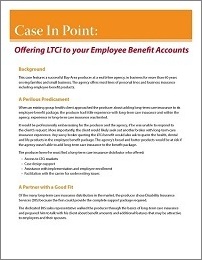What it is
Voluntary multi-life long-term disability insurance is a valuable enhancement to existing benefit offerings. More employees are becoming aware of the need for long-term care insurance protection. Whether they are experiencing it first-hand as a caregiver to a loved-one or they know someone who is experiencing the need, they are realizing that a long-term need can impact all aspects of life. Employees value long-term care insurance and they want it.
For employers, a voluntary long-term care insurance program can:
- Enhance existing benefit offerings.
- Encourage employee productivity by reducing the risk of an employee becoming a caregiver.
- Retain quality employees who desire a new benefit, reducing the hiring and training costs associated with turnover.
- Offer a valued benefit with little or no cost to the company – with a program to educate employees and full-service enrollment program.
- Provide various tax advantages for company under certain company ownership structures.
For employees, a voluntary long-term insurance program provides
- Access to qualified coverage for employees, their spouses/partners, and other family members at a program discount.
- Asset protection.
- Reduced underwriting requirements.
- A fully portable, individual policy they can carry forward throughout employment changes.
- Simple payment through payroll deduction.
How to explain it
Use the points below to explain the overwhelming upside of offering voluntary LTCI to your employer clients. Emphasize that they can offer this valued benefit with little or no cost to the company.
- Meaningful benefits continue to retain and attract employees: 60% of employees say that the benefits offered are an important reason why they remain with their employers. 49% of employees say benefits offered were an important reason they decided to work for their employers.1
- Long-term care insurance is the #1 voluntary benefit that employees are requesting that businesses that today they don’t currently offer.2
- Caregiving employees conservatively cost U.S. employers $13.4 billion per year.3
- On a case-study analysis, 12% of employees reported caregiving for an older person, and generally those caregiving employees reported poorer health and more chronic disease than non-caregivers.3
- Forty percent of those individuals currently receiving long-term services are under the age of 65.4
- Employees may be balancing work with the role of caregiver. The average boomer now has more parents than children to care for, and productivity losses due to caregiving are growing astronomically.4
[1] American Association for Long-Term Care Insurance, 2011 LTCI Sourcebook
[2] “What’s Hot and What’s Not in Voluntary Benefits,” Aon Consulting Study, 2006
[3] “Working Caregivers and Employer Health Care Costs,” National Alliance for Caregiving, 2010
[4] Shelton, Phyllis. Long-Term Care: Your Financial Planning Guide. Tennessee: LTCI Publishing, 2007
When to offer it
Offer voluntary multi-life LTCI benefits to groups with three or more employees.
Suggested Resources



